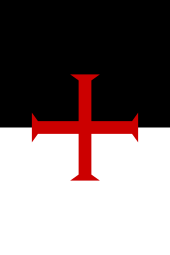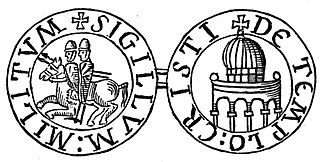
The Poor Fellow-Soldiers of Christ and of the Temple of Solomon, mainly known as the Knights Templar, was a French military order of the Catholic faith, and one of the wealthiest and most popular military orders in Western Christianity. They were founded c. 1119, headquartered on the Temple Mount in Jerusalem, and existed for nearly two centuries during the Middle Ages.

Pope Clement V, born Raymond Bertrand de Got, was head of the Catholic Church and ruler of the Papal States from 5 June 1305 to his death, in April 1314. He is remembered for suppressing the order of the Knights Templar and allowing the execution of many of its members. Clement moved the Papacy from Rome to Avignon, ushering in the period known as the Avignon Papacy.
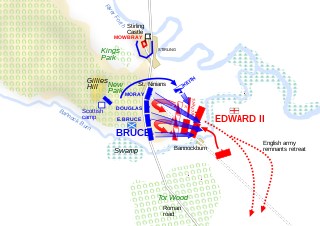
1314 (MCCCXIV) was a common year starting on Tuesday of the Julian calendar, the 1314th year of the Common Era (CE) and Anno Domini (AD) designations, the 314th year of the 2nd millennium, the 14th year of the 14th century, and the 5th year of the 1310s decade. As of the start of 1314, the Gregorian calendar was 8 days ahead of the Julian calendar, which was the dominant calendar of the time.

Philip IV, called Philip the Fair, was King of France from 1285 to 1314. By virtue of his marriage with Joan I of Navarre, he was also King of Navarre as Philip I from 1284 to 1305, as well as Count of Champagne. Although Philip was known to be handsome, hence the epithet le Bel, his rigid, autocratic, imposing, and inflexible personality gained him other nicknames, such as the Iron King. His fierce opponent Bernard Saisset, bishop of Pamiers, said of him: "He is neither man nor beast. He is a statue."

Jacques de Molay, also spelled "Molai", was the 23rd and last grand master of the Knights Templar, leading the order sometime before 20 April 1292 until it was dissolved by order of Pope Clement V in 1312. Though little is known of his actual life and deeds except for his last years as Grand Master, he is one of the best known Templars.

The Council of Vienne was the fifteenth ecumenical council of the Catholic Church and met between 1311 and 1312 in Vienne, France. One of its principal acts was to withdraw papal support for the Knights Templar at the instigation of Philip IV of France. The Council, unable to decide on a course of action, tabled the discussion. In March 1312 Philip arrived and pressured the Council and Clement to act. Clement passed papal bulls dissolving the Templar Order, confiscating their lands, and labeling them heretics.

Guillaume de Nogaret was a French statesman, councilor and keeper of the seal to Philip IV of France.

Rothley Temple, or more correctly Rothley Preceptory, was a preceptory in the village of Rothley, Leicestershire, England, associated with both the Knights Templar and the Knights Hospitaller.
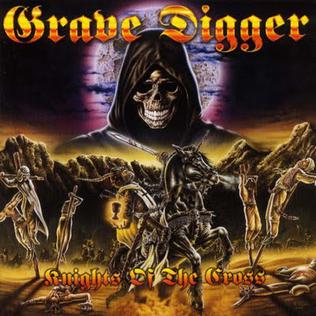
Knights of the Cross is the eighth studio album by German heavy metal band Grave Digger, released in 1998. It is the second album of the Middle Ages Trilogy.

The Square du Temple is a garden in Paris, France in the 3rd arrondissement, established in 1857. It is one of 24 city squares planned and created by Georges-Eugène Haussmann and Jean-Charles Adolphe Alphand. The Square occupies the site of a medieval fortress in Paris, built by the Knights Templar. Parts of the fortress were later used as a prison during the French Revolution, and then demolished by the mid-19th century.

The Chinon Parchment is a historical document discovered in September 2001 by Barbara Frale, an Italian paleographer at the Vatican Apostolic Archive. On the basis of this document she has claimed that, in 1308, Pope Clement V absolved the last Grand Master, Jacques de Molay, and the rest of the leadership of the Knights Templar from charges brought against them by the Medieval Inquisition.
The Poor Fellow-Soldiers of Christ and the Temple of Jerusalem, or Templars, was a military order founded in c. 1120.
The original historic Knights Templar were a Christian military order, the Order of the Poor Fellow Soldiers of Christ and of the Temple of Solomon, that existed from the 12th to 14th centuries to provide warriors in the Crusades. These men were famous in the high and late Middle Ages, but the Order was disbanded very suddenly by King Philip IV of France, who took action against the Templars in order to avoid repaying his own financial debts. He accused them of heresy, ordered the arrest of all Templars within his realm, put the Order under trial and many of them burned at the stake. The dramatic and rapid end of the Order led to many stories and legends developing about them over the following centuries. The Order and its members increasingly appear in modern fiction, though most of these references portray the medieval organization inaccurately.
Hugues de Pairaud was one of the leaders of the Knights Templar. He and Geoffroi de Gonneville were sentenced to life imprisonment on March 18, 1314. They were spared the fate of Jacques de Molay and Geoffroi de Charney, who were both burned at the stake, because they accepted their sentence in silence.

In 1307, members of the Knights Templar in the Kingdom of France were suddenly charged with heresy and arrested after their leader, Master Jacques de Molay, had recently come to France for meetings with Pope Clement V. Many, including their leader, were burned at the stake while others were sentenced to perpetual imprisonment. The events in France led to a series of trials in other locations, not all of which had the same outcome.

The fall of Ruad in 1302 was one of the culminating events of the Crusades in the Eastern Mediterranean. In 1291, the Crusaders had lost their main power base at the coastal city of Acre, and the Muslim Mamluks had been systematically destroying the remaining Crusader ports and fortresses in the region, forcing the Crusaders to relocate the dwindling Kingdom of Jerusalem to the island of Cyprus. In 1299–1300, the Cypriots sought to retake the Syrian port city of Tortosa, by setting up a staging area on Ruad, two miles (3 km) off the coast of Tortosa. The plans were to coordinate an offensive between the forces of the Crusaders, and those of the Ilkhanate. However, though the Crusaders successfully established a bridgehead on the island, the Mongols did not arrive, and the Crusaders were forced to withdraw the bulk of their forces to Cyprus. The Knights Templar set up a permanent garrison on the island in 1300, but the Mamluks besieged and captured Ruad in 1302. With the loss of the island, the Crusaders lost their last foothold in the Holy Land and it marked the end of their presence in the Levant region.

Requiem is a novel by Robyn Young set during the end of the ninth and final crusade. It was first published by E.P. Dutton in 2008.

The Larmenius Charter or Carta Transmissionis is a coded Latin manuscript purportedly created by Johannes Marcus Larmenius in February 1324, detailing the transfer of leadership of the Knights Templar to Larmenius after the death of Jacques de Molay. It also has appended to it a list of 22 successive Grand Masters of the Knights Templar after de Molay, ending in 1804, the name of Bernard-Raymond Fabré-Palaprat appearing last on the list. The document is written in a supposed devised ancient Knights Templar Codex. Actually in Freemason custody, the document is kept at the Mark Masons Hall in London. Some researchers have concluded that it is a forgery, while others assert its authenticity.
The history of the Knights Templar in England began when the French nobleman Hugues de Payens, founder and Grand Master of the Order, visited the country in 1128 to raise men and money for the Crusades.
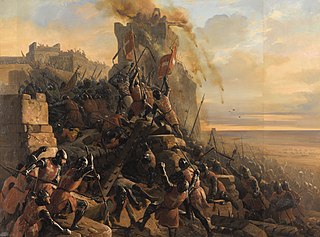
The Crusades after Acre, 1291–1399 represent the later Crusades that were called for by papal authorities in the century following the fall of Acre and subsequent loss of the Holy Land by the West in 1302. These include further plans and efforts for the recovery of the Holy Land, the later popular Crusades, Crusades against Christians, political Crusades, the latter parts of the Reconquista, and the Northern Crusades. Crusades were to continue well into the fifteenth century and would include those against the Ottoman Empire.
